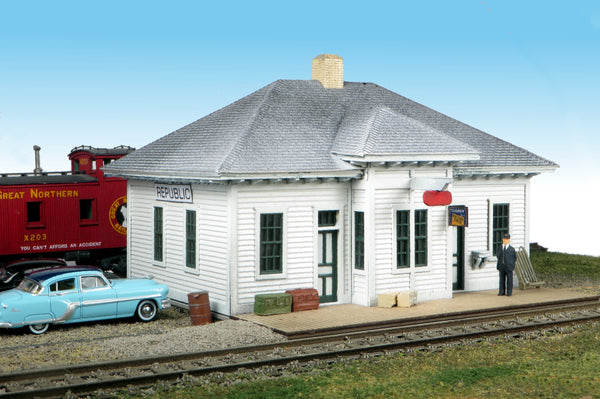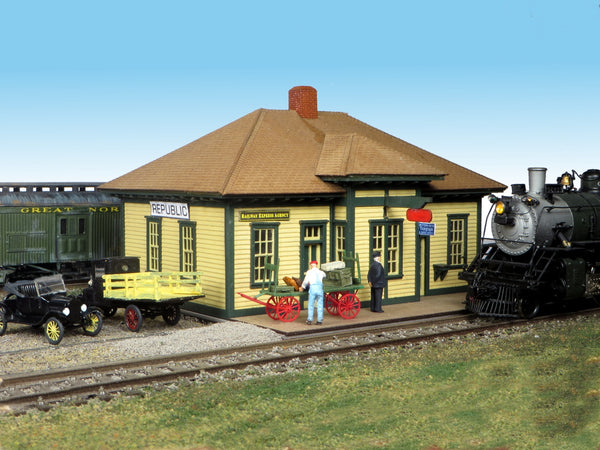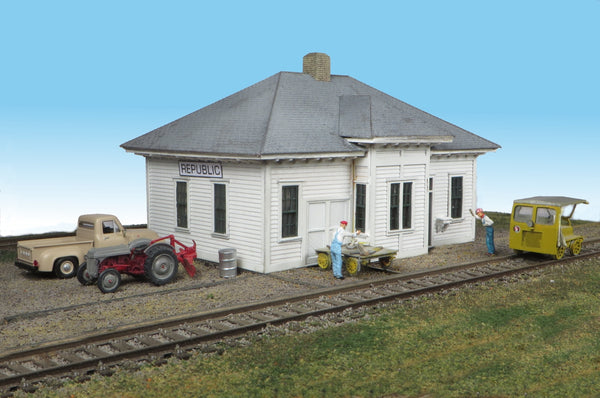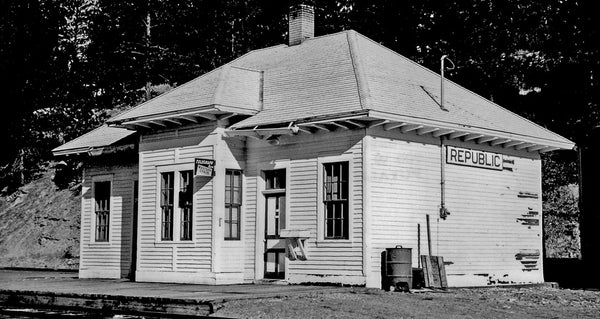Republic, Washington, depot 24x36 - HO
The Great Northern Railway Historical Society Company Store is proud to offer an HO-scale, laser cut kit of the 24’ x 36’ Republic, Washington, depot custom made by Monroe Models. We are offering Republic as a 'not quite standard' small-town depot.
The Republic depot was built at the end of the Republic, Washington, branch in 1902 as a 24 x 96’ standard plan combination depot. Because it was located at the end of a branch and served a booming mining town, the company expected substantial Less than Carload (LCL) freight traffic, so the depot received an unusually long freight room. In 1964, with both LCL freight and passenger service gone, the building was shortened by removing the freight room. One passenger waiting room was converted for use as a speeder shed by the section crew while the other continued to be the business office for use by freight customers. It retained its decorative roof peak over the bay window, which was characteristic of depots on this line of railroad north of Marcus, Washington.
The kit
The kit is a laser-cut basswood structure kit with laser-cut doors, windows, trim, etched platform with three-dimensional shingle sheets and cast detail. Directions include photos and diagrams for easy step by step construction. The overall footprint, including platform, is 5 inches long by 4 3/4 inches deep.
You may build your model as Republic really was in 1964 and later, a freight only structure that housed the Freight Agent and the Section Foreman’s speeder.
You can also build your model as a combination telegraph office and passenger depot and use paint to establish the era. Separate wall panels are included to enable you to build the kit either way.
See RS 35 about the depot as remodeled, and RS 397 which includes early photos of the depot showing it as built with a long freight room and details about Republic and the Eureka Gulch Spur which served gold mines and mills beyond the depot.
Paint Colors
The Great Northern Railway changed its paint scheme for wooden buildings, including depots, from time to time. This makes the color of frame buildings a clue to the time frame you are modeling.
Photos taken shortly after the Republic depot was built show it was painted with relatively dark colors, probably red with green window trim. Beginning in 1909, GN frame depots were painted medium yellow-buff on large wall sections with a darker olive green trim on windows and doors, belt rails and corner posts. We have photos of Republic in that paint scheme. In September of 1930, the two-tone gray scheme was introduced, which was followed by the 1950 or so white with green trim. Photos in RS 35 show the building was painted all white after it was shortened. Station name boards were always white with black lettering and black trim along the edges.
Explanatory notes:
Note 1: No evidence has been found in AFE or corporate files for dark green or red trim on early mineral red depots. All reference to dark green or red trim is anecdotal and not supported by any documents, but some think it is consistent with available black and white photos.
Note 2: The change to yellow-buff with olive green trim was made official with the new 1909 depot style featuring belt rails, boxed eaves, angled bay, and different siding widths above and below the belt.
Note 3: In Reference Sheet 402 the term “yellow-buff” was used, rather than the yellow-ochre of RS 53 which called the depot trim a “darker ochre.” That term is very confusing and not at all descriptive of a color with a definite green cast. There was some confusion among GNRHS members about these colors when these ochre descriptions were written in the 1970s.
Note 4: Existing depots continued in service after 1909. It took time for existing depots to be painted in the new colors; some never were, but went directly to two-tone gray sometime after September, 1930, when that standard was introduced.
Note 5: Actual boards collected from several depots now exist in the JSRH Archives in St. Paul. These boards have colors consistent with the colors as described here. The colors stated here are also confirmed in documents and corporate files located at JSRH and Minnesota History Museum. Martin Evoy’s extensive files preserved at JSRH have also been carefully examined, as well as paint chips collected by Martin and others.
Note 6: A few depots located on the branch between Alexandria, MN and St. Cloud, MN are thought to have been painted gray with mineral red trim. Examination of paint layers on the boards in the depot in Dalton, MN supports this.
See RS 53 about painting frame depots, RS 154, and RS 402 about paint schemes at various times.








